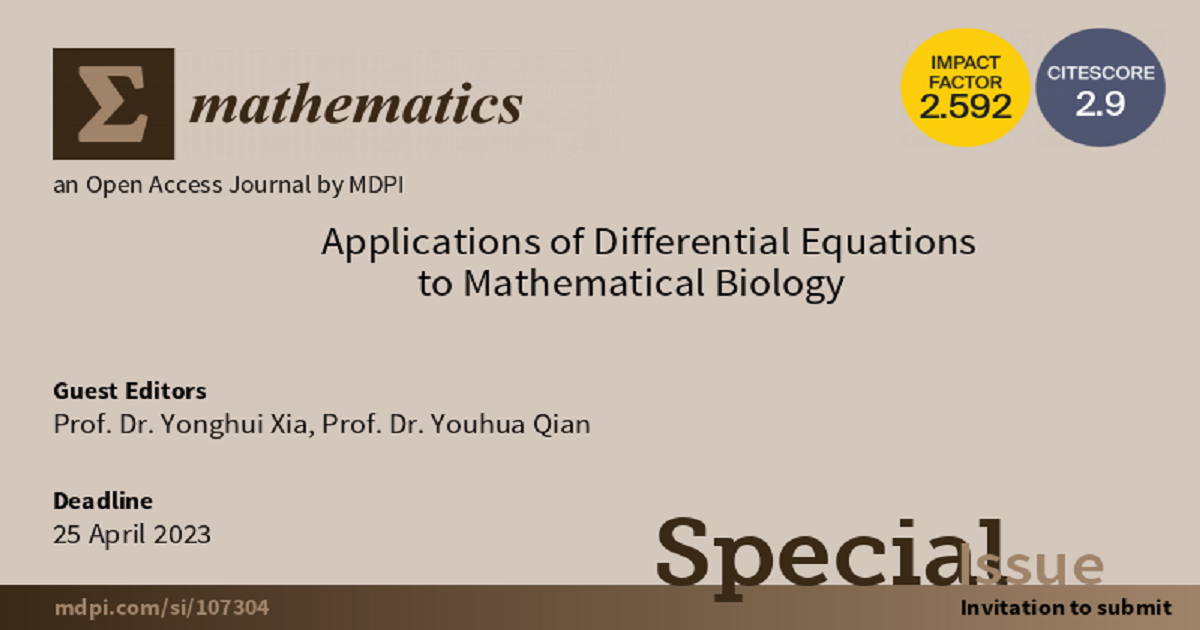Applications of Differential Equations to Mathematical Biology
A special issue of Mathematics (ISSN 2227-7390). This special issue belongs to the section "Mathematical Biology".
Deadline for manuscript submissions: closed (25 April 2023) | Viewed by 19592

Special Issue Editors
Interests: differential equations includes theory of the Quaternion Differential Equations, Hartman-Grobman linearization and spectrum; travelling waves of PDE models; qualitative theory of ODEs such as limit cycles and periodic solution; stability analysis in nonlinear systems, mathematical biology, neural networks (including continuous, discrete and impulsive systems)
Interests: homotopy analysis method; chaotic theory and bifurcation theory; bursting oscillation
Special Issues, Collections and Topics in MDPI journals
Special Issue Information
Dear Colleagues,
In the last few decades, theories of the ordinary or partial differential equations has become a rapidly growing area of research. The attractiveness of this field not only derives from theoretical interests, but also differential equations, which have many applications in several phenomena observed in applied sciences. In particular, mathematical biology has attracted many researchers’ interests. We invite researchers to submit original research articles as well as review articles on theory of ordinary or partial differential equations and their applications to mathematical biology. Potential topics included, but are not limited to:
- Special orbits for ordinary differential equations and their applications to mathematical biology;
- Lyapunov stability for conservative and dissipative systems and their applications to mathematical biology;
- Dichotomy and dynamical spectrum;
- Topological linearization and topological conjugacy;
- Stability of differential, functional and difference equations and their applications to mathematical biology;
- Qualitative theory of solutions of dynamic systems and their applications to mathematical biology;
- Periodic and almost periodic solutions of differential, functional, impulsive, and difference equations and their applications to mathematical biology;
- Periodic and almost periodic solutions of neutral equations;
- Bifurcations and chaos with their applications to mathematical biology.
Prof. Dr. Yonghui Xia
Prof. Dr. Youhua Qian
Guest Editors
Manuscript Submission Information
Manuscripts should be submitted online at www.mdpi.com by registering and logging in to this website. Once you are registered, click here to go to the submission form. Manuscripts can be submitted until the deadline. All submissions that pass pre-check are peer-reviewed. Accepted papers will be published continuously in the journal (as soon as accepted) and will be listed together on the special issue website. Research articles, review articles as well as short communications are invited. For planned papers, a title and short abstract (about 100 words) can be sent to the Editorial Office for announcement on this website.
Submitted manuscripts should not have been published previously, nor be under consideration for publication elsewhere (except conference proceedings papers). All manuscripts are thoroughly refereed through a single-blind peer-review process. A guide for authors and other relevant information for submission of manuscripts is available on the Instructions for Authors page. Mathematics is an international peer-reviewed open access semimonthly journal published by MDPI.
Please visit the Instructions for Authors page before submitting a manuscript. The Article Processing Charge (APC) for publication in this open access journal is 2600 CHF (Swiss Francs). Submitted papers should be well formatted and use good English. Authors may use MDPI's English editing service prior to publication or during author revisions.
Keywords
- stability
- bifurcations and chaos
- mathematical biology
- periodic and almost periodic solutions
- dichotomy and dynamical spectrum
- topological conjugacy





